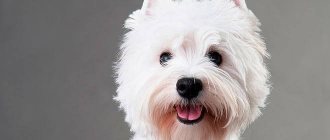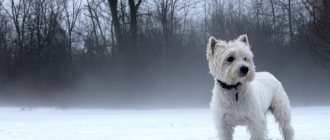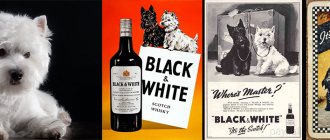The West Highland White Terrier is a breed of hunting dog developed in Scotland. It is quite ancient and has long been used for hunting small burrowing animals. Despite its small size, this dog is active, efficient and courageous. She is now popular as a companion due to her peaceful nature and cheerful disposition. Before getting a West Highland White Terrier, it is worth studying the description of the breed and a video about it. Reviews from the owners will help you learn about its character, pros and cons of its content.
- Head
- Education and training
- Grooming
Breed traits
Breed traits (on a 5-point scale)
| West Highland White Terrier | |||
| Activity | in the house | 3.4 | |
| on the street | 3.9 | ||
| Obedience | training | 3.4 | |
| strangers | 3.4 | ||
| Domination | in family | 2.4 | |
| over dogs | 3.2 | ||
| Defending your territory | from people | 2.2 | |
| from dogs | 3.3 | ||
| Sociability | in family | 4.8 | |
| with strangers | 3.8 | ||
| with dogs | 3.5 | ||
| Concentration | in family | 1.4 | |
| in front of strangers | 2.1 | ||
| with dogs | 2.1 | ||
| Aggressiveness | in family | 1.5 | |
| to strangers | 2 | ||
| to the dogs | 2.6 | ||
| to cats | 3.2 | ||
| Family behavior | calmness | 4 | |
| demand for affection | 4.3 | ||
| excitability | 3.9 | ||
| playfulness | 4.8 | ||
| excessive barking | 2.8 | ||
| behavioral breakdowns | 2.4 | ||
| Tolerance for children | up to 4 years | 3.1 | |
| over 4 years old | 4 | ||
| Institutional use | watchman | 4.1 | |
| bodyguard | 2.1 | ||
This breed is often compared to the following dog breeds: Maltese (Maltese Bichon), Cairn Terrier, Bichon Frize, Miniature Schnauzer (Dwarf Schnauzer), Scotch Terrier (Scottish Terrier).
The photo shows what a West Highland White Terrier looks like:
Character
A mischievous mischief maker who sticks his nose into everything - this is about the West Highlander. The dog is sociable, with a friendly attitude towards people. Westies adapt to their owner, they are unobtrusive, but will gladly take part in games and other activities. Its funny appearance and playfulness make the Westie a good companion for a child. He is devoted to his family, but also treats strangers kindly.
Animals of this breed are suitable for any person who is ready to pay attention to them. The dog is convenient for travel, suitable for agility, freestyle, frisbee and search work.
The dog is convenient for travel, suitable for agility, freestyle, frisbee and search work.
Some breeders test their pets for working qualities by bringing them in for training. Here the dogs are trained to work on animals in an artificial hole. Few people get to the point of actually hunting.
Westies have a pronounced hunting instinct. Leaving him alone with pet rodents and ferrets is risky. This dog is loyal to “his” cats if he has been accustomed to them since childhood.
Westies love and do not hurt children
This little white terrier is self-confident and has a sense of self-esteem. The enemy's attack will be met with a fierce attack, and its size does not matter.
General characteristics of the West Highland White Terrier breed
The West Highland White Terrier is a funny and cheerful fidget. This is a snow-white shaggy dog with a smart, attentive look. He is curious, good-natured and energetic. The name West Highland White Terrier can be translated as Western Highland White Terrier. This is due to the place of breeding and the color of the coat. Breeders and owners often call these dogs Westie, Westie or Westie.
This dog, once a passionate hunter, is now being adopted as a companion. But she did not become a decorative dog. This is a very mobile, active dog. He is cheerful and restless, ready to run and play all day long, and loves adventures. Easy to learn tricks, can be used in sports such as agility, freestyle.
| Options | Characteristic |
| breed name | West Highland White Terrier |
| a country | Scotland |
| group of breeds according to the ICF classification | Terriers, small terriers section |
| application | hunter, companion |
| character traits | cheerful, active, devoted, peace-loving, brave, inquisitive |
| appearance features | hard shaggy white coat, strong compact build, large head, short tail |
| life expectancy | 13-16 years old |
| height | males 25-30 cm, females 23-28 cm |
| weight | males 7-10 kg, females 6-7 kg |
| aggressiveness | low |
| activity | high |
| intelligence | high |
| difficulty of care | complex, coat needs trimming |
pros
Due to their small size, representatives of this breed can easily get along even in a small apartment. If you provide your dog with sufficient exercise and outdoor games, there will be no problems with its maintenance. These dogs have the following advantages:
- have a funny, attractive appearance;
- cheerful, playful;
- smart, inquisitive;
- peaceful, do not show aggression towards people or other dogs;
- loyal, strongly attached to the owner;
- good-natured and not aggressive;
- wool does not cause allergies, does not shed and does not smell
Minuses
This breed is suitable only for people leading an active lifestyle. The dog is very restless, energetic, and needs a lot of physical activity. He needs early socialization and serious education. Representatives of this breed have several more disadvantages:
- noisy, loud and bark a lot;
- do not get along with small pets and hunt them;
- stubborn, prone to dominance;
- love to dig;
- cannot stand loneliness;
- Grooming required.
The video complements the characteristics of the breed:
Video: West Highland White Terrier - all about the breed
Video: West Highland White Terrier // advantages of the breed
Video: Disadvantages of the West Highland White Terrier breed // features of the breed
How much does it cost to own a dog?
You will initially have to spend a large amount of money on maintaining a dog. You need to purchase accessories for care. Further monthly expenses are 3-5 times lower; you only need to purchase food, care products and sometimes medicine. In addition to spending money, you need to consider how much attention and time the animal requires.
For preliminary calculations, you need to make a list of desirable and obligatory expenses. Divide the cost of each product by the number of months, and then add up the results. The main expense is feeding. Consider the characteristics of the breed. For example, a purebred representative of decorative breeds may need the services of a groomer.
The most expensive is the first year of maintenance. During this period, you need to make one-time purchases and pay for services. In subsequent years, stable expenses consist of spending on food, a veterinarian, shampoos, and antiparasitic agents.
If we add up the amount of one-time and permanent expenses, the first year requires an investment of 54,336, that is, 4,528 per month at a minimum. Subsequent years of maintenance require an investment of 3500/month.
History of the origin of the West Highland White Terrier breed
Dogs of the West Highland White Terrier breed have been known in Scotland since the Middle Ages. They hunted small animals - otters, badgers, and protected the farm from rodents. Short legs and a small, strong body helped them climb through rocks in mountainous areas and climb into narrow holes in pursuit of game. There is no reliable version about their origin, but many researchers believe that they were bred from English Cairn Terriers.
In those days, representatives of this breed could have different colors. On the contrary, white people were not welcome. Only at the end of the 19th century, two Scots: Colonel Edward Malcolm and Duke of Argyll George Campbell began to breed white terriers. They believed that this color was convenient when hunting in the field, since the hunter would not confuse the pet with an animal.
After their first appearance at a show in London in 1904, these dogs became popular. The breed was given this name. The first breed clubs began to be created. At first, the West Highlands were considered relatives of the Cairn Terrier and Scotch Terrier. In 1930, the final standard for the breed was created and it was officially recognized as a separate breed.
Pros and cons of the breed
The general characteristics of the West Highland White Terrier breed are more than positive; the disadvantages and advantages of these animals are outlined in more detail in the table below.
| pros | Minuses |
| Compact size and good looks | Possible stubbornness |
| Good learning ability | Tendency to various allergic reactions |
| Cheerful and friendly disposition | Specific coat care |
| Loyalty to the owner | Need for long walks |
Expert opinion
Leonid Rodin
Experienced dog breeder
Ask a Question
The West Highland White Terrier appears small, but this is an optical illusion caused by its light coat. The dog is strong, energetic and vocal - like other representatives of its species, it is accustomed to barking and does it even underground, making its way through burrows. Few people know that in the heat of a hunt, West Highland White Terriers are able to squeeze into very narrow crevices, in which they sometimes get stuck. Then the owner has to rescue the unlucky dog from the underground trap. A similar danger awaits the dog even at home. He is able to get captured under a refrigerator or stick his head into the metal insides of a heating radiator. There are two points to note. Firstly, the West Highland White Terrier is jealous - he does not want to share his owner’s love with any family member. Secondly, in the summer this dog can get sunburned. The sun's rays are especially dangerous for the ears. It is even recommended to treat them with a special cream so that your four-legged pet avoids burns. Otherwise, the Scottish breed is considered quite comfortable and convenient for home keeping.
The West Highland White Terrier breed is a wonderful companion for easy-going people who love hiking and traveling. However, in order to ensure a happy life for the dog, the owner must be willing to spend time on care, education and games.
West Highland White Terrier Appearance Standard
The West Highland White Terrier is a small dog with a harmonious build. The height of males is on average 28-30 cm, females - up to 26 cm. The weight of dogs does not exceed 10 kg, smaller females weigh 6-7 kg. In appearance, they are a little similar to the Bichon Frize, but are sturdier, stronger and more active.
Head
The head is large, the skull is wide, with prominent brow ridges. The muzzle is of medium length, tapering slightly towards the nose. The bridge of the nose is straight, the stop is sharp, well defined, the lobe is large and black. The jaws are powerful and have a scissor bite. The lips are tightly compressed, dry, black.
The eyes are almond-shaped, set wide and deep. The color of the iris is almost black, the whites are not visible. The look is smart, attentive. The ears are small and erect. They have a triangular shape with sharp tips. Planted close together on the crown of the head.
Frame
The neck is of medium length, muscular, gradually widening towards the body. The body is compact, almost square in shape. The chest is deep, the lower part of the body is level. The back is straight, short, the croup is wide. The tail is straight, of medium length (12-15 cm), held almost vertically. Should not lie on your back or twist.
Limbs
The limbs are straight, short, and muscular. The front ones may be slightly everted, which is due to these dogs' past as burrowers. The thighs are wide, sinewy, and the joints are well defined. The paws are rounded, the toes are clenched. When moving, the dog places its limbs parallel and pushes off powerfully from the ground. She is resilient, runs fast, and can jump high.
Coat and color
The West Highland White Terrier has a medium-length, double coat. The guard hair is straight, hard, shiny and requires regular trimming. The length on the body reaches 5 cm, the longest it is on the stomach. The hair on the head, ears, front surface of the limbs, and tail is shorter. There is a soft, thick undercoat, like fur, that fits tightly to the body. This coat protects the skin from branches, thorns and bad weather.
The color standard for representatives of this breed is only white. There should be no stains. It should be taken into account that the color depends on nutrition and care characteristics. Sometimes the fur may acquire a yellowish tint, and on the mustache and under the eyes it may turn brown.
Photos complement the description of the appearance of West Highland:
How to name a dog: popular nicknames
It is recommended that the whole family choose a pet name so that everyone likes it. To please your four-legged friend, you must adhere to certain rules:
- The nickname should be short. Long names are not easy to pronounce regularly;
- It’s better to choose a well-known word that will be easy to remember. These can be heroes of films, cartoons or simple fairy tales;
- The nickname should consist of no more than two syllables. This way it will be easier for the animal to remember it;
- it must begin with a consonant. According to experts, pets remember such nicknames better. However, today there are a lot of names that begin with a consonant and sound very beautiful;
- the name must be unique. This will help avoid confusion when walking in the park where other pets are walking.
Nicknames that are now popular for boys are: Archie, Cupid, Ax, Bucks, Baron, Butch, Jack, Dick, Zhorik, Nike, Peach, etc.
Girls can be called Terry, Julia, Greta, Silva, Valencia, Gerda, Juliana, Kira, Zhuzha, Cleopatra, Coco, Leila.
Character of the West Highland White Terrier
West Highland White Terriers are very sociable, cheerful, and do not tolerate loneliness. They differ from other varieties of terriers in their good nature and loyalty. They love to be the center of attention, to be praised and admired. They communicate well with school-age children, they can become best friends and spend all day playing. But they will not tolerate being hurt, so it is better to prevent them from interacting with children.
These terriers are funny, good-natured and even-tempered. Although they can be stubborn, jealous and prone to dominance. But if you find the right approach to training, he will be an obedient and affectionate companion. This dog is sensitive, able to lift a person’s mood and support.
It is necessary to take into account the following features of the character of the news:
- intelligence;
- curiosity;
- independence;
- energy;
- initiative;
- friendliness;
- cheerfulness;
- courage;
- stubbornness.
The ancestors of these dogs were bred for hunting. Although these dogs are now used as companions, their hunting instincts remain. Westies can chase small animals, hunt rodents, and dig up flower beds. It is better for people leading an active lifestyle, athletes, and tourists to own dogs of this breed. With proper upbringing, they live calmly in the same house with other animals, although they can be jealous of their owner.
Westies have sensitive hearing and a keen sense of smell, so they can be watchmen. Although they can only warn the owner by barking that a stranger is approaching. Westies do not show aggression even towards strangers. But in case of danger, they boldly rush to protect their owner.
Education and training
Dogs of this breed are smart, quick-witted, and easy to train. And thanks to their energy and curiosity, they love to learn new things. But training these dogs is difficult. They will only obey a person who has been able to gain authority from them. You should not entrust education to children, people with weak character and inexperienced dog breeders.
Another difficulty is to lead people who are wayward, stubborn and lazy, who are constantly distracted and love to frolic. Therefore, in training you need to adhere to the following tips:
- immediately when a puppy appears in the house, show him who is in charge;
- show patience, perseverance, you need to be moderately strict, but caress the dog more often, show your love;
- conduct classes regularly, periodically repeating the material covered;
- training should be short, alternating with outdoor games;
- classes should be carried out in a calm environment, preferably so that the dog is not distracted by anything;
- be sure to reward your pet with a treat for correctly following the command;
- You cannot shout, use physical punishment, or use a stern tone or ignore them in case of disobedience.
The dog must be taught the rules of behavior from an early age. Do not allow him to growl at the owner and family members, bite arms or legs, jump on the bed, or beg for food. On the street, immediately teach people not to run after cats and other animals. But it is unlikely that you will be able to wean yourself off the desire to dig.
The puppy needs to be accustomed to the place, collar and leash. The pet must respond to its name and immediately approach the owner’s call. Up to 10 months, the dog should understand the basic commands: “come to me”, “near”, “no”, “stand”, “fu”, “sit”. After 10 months, you can attend training courses and dog parks.
Currently, West Highland White Terriers are not used for hunting. At exhibitions they don’t even evaluate working qualities. But if you wish, you can train a pet and hunt burrowing animals with it. These dogs are fearless, passionate, and resilient.
The photographs show the behavioral features of these dogs:
How to properly care for your pet
Active, energetic, he loves long, active walks. If he lives in a city apartment, then they are a first necessity. In cold weather, his paws freeze, so before going out you need to put on a suit and boots.
Grooming: haircut
Wool requires serious care. Dogs do not shed, so they need to be trimmed every 3 months. The coat is brushed every week, once or twice. The fur that grows on the face needs to be combed every day with a comb.
Frequent water treatments will cause the coat to lose its appearance and become too soft. To avoid this, you should not wash it often, and you can only cut your dog by hand.
How to make a proper diet
Nutrition needs to be thought out, it must be well balanced. Metabolic disorders due to poor nutrition lead to serious problems. It is better if the type of food chosen is natural. If using dry food, it must be rice, turkey, lamb or fish based. Wheat and chicken in the diet cause allergies in dogs.
If a dog is bred for exhibitions, then it is better to avoid eating carrots and beets, as these products can cause its coat to turn yellow.
Vitamins should be added to food constantly. A moderate diet will help her avoid gaining excess weight.
How to approach training
Dogs of this breed have a good mind and quick learning ability. But the nature of dogs is stubborn, which often causes difficulties in training.
The beginning of training should occur in the first days of the pet’s stay with the owner.
In order for the dog to obey, you need to use:
- Patience;
- Clarity of tasks;
- Consistent actions;
- Promotion
The pet needs to be loaded with physical and mental tasks, this will not let him get bored. Active sports are suitable for such a dog. He will even be interested in circus training.
What diseases is your dog predisposed to?
With good care and proper nutrition, he can live 12-15 years.
Various diseases can overtake him if he is not cared for.
Such diseases include:
- Allergy;
- Cataract;
- Diabetes;
- Deafness;
- Skin problems.
At the first sign of any illness, you should consult a doctor. If diseases are treated correctly in the early stages, their development can be easily avoided.
Features of maintenance and care
West Highland White Terriers are indoor dogs. They live quietly in a house or city apartment. Although they are unpretentious and tolerate any weather conditions well. But many owners put clothes on their pets when going outside to keep their fur snow-white.
Due to its small size, the white terrier can be trained to go to the toilet at home using a diaper or litter tray. But it is necessary to take them outside. Adult dogs need to be walked 2-3 times a day for 40-60 minutes. Walks should be active, with outdoor games. Representatives of the breed are ready to run all day, but physical activity should be limited, especially in puppies - this can lead to problems with the joints.
It is recommended to visit parks, dog parks, and take your dog out into nature. But in the city it is better not to let your pet off the leash. A Vestik can dig up a flowerbed or lawn, chase a rat, or wallow in carrion. Interested in an unfamiliar smell, he may run away. Therefore, the dog needs to be loaded with physical and intellectual exercises. Representatives of the breed love to fetch a ball or stick and look for hidden objects.
At home, you need to give your pet a comfortable place away from drafts and heating appliances. There should be soft bedding and a lot of toys so that the dog can entertain himself when he is left alone. Like all terriers, representatives of this breed love to steal small things and hide them in their place.
Grooming
Representatives of this breed are unpretentious and caring for them is not difficult. But to maintain the beauty of its snow-white coat, regular grooming will be required.
Like all wire-haired dogs, the Westie's coat does not shed. The hair falls out, but remains in the coat and falls off. Therefore, these dogs are trimmed regularly. Haircutting is not recommended. After this, the hair becomes soft, begins to curl and fall into tangles. The groomed dog of this breed looks like a lapdog. But some owners who do not show their pets give it haircuts in the summer to make it easier to care for its coat.
You can trim your West Highland White Terrier yourself or go to a grooming salon. It is recommended to do this for an adult dog 3-4 times a year. The first time the procedure is performed is 3-4 months. This will help form the correct silhouette and achieve the multi-layered coat that representatives of the breed should have.
Before the procedure, the hair must be combed well. Using a stripping knife, shorten the hair at the elbows and on the throat. On the back and neck, you need to achieve an even coat 4-5 cm long. On the head and ears, the hair is trimmed by hand. You don't have to touch the limbs. A properly trimmed dog looks attractive: the hair is short on the sides, longer on the chest, and there is a neat mustache and beard on the face.
To care for the West Highland White Terrier, you will also need grooming - regular hygiene procedures.
- You need to bathe your dog once every 1-3 months. These dogs are clean, their coat does not emit a specific odor. You need to use a special shampoo for white wool. It is advisable that it be designed for wire-haired dogs.
- To maintain the whiteness of the wool, places where it turns yellow must be periodically bleached. A mixture of crushed chalk and boric acid is suitable for this. Moisten the wool, rub in the mixture, and then comb out the remaining chalk.
- The dog should be combed 1-2 times a week with a wide-toothed metal comb. Dogs that have their hair cut are brushed more often, as their hair quickly becomes tangled.
- It is recommended to wash your paws after every walk. In rainy weather, it is better to use waterproof clothing so that the dog does not get his belly dirty. In winter, roads are sprinkled with reagents that can corrode the pads, so they must be regularly inspected and lubricated with oil.
- After eating, it is recommended to wipe the face to remove any remaining food. This will help prevent yellowing of the coat and the appearance of an unpleasant odor.
- The hair on the face, paws and under the tail can be trimmed. This will make it easier to keep clean. If the dog is not being shown, it can have decorative haircuts.
- You need to clean your ears once a week. Be sure to pluck the hairs inside the ear, as they impede ventilation and can cause inflammation.
- Wipe your eyes daily. If red streaks appear under them, the dog may have an allergy. It's better to consult a veterinarian.
- You need to brush your pet's teeth a couple of times a week. To prevent tartar, you can give chewing bones and special treats.
- If your pet doesn't walk on the pavement a lot, its claws won't wear down. In this case, it is recommended to shorten them once a month with a nail clipper.
- In the warm season, be sure to treat the coat against external parasites.
Nutrition
You can feed your West Highland White Terrier either dry food or natural food. Usually the feeding method is chosen by the nursery, and then it is not recommended to change it immediately. The transition to another diet should be gradual. An adult dog is fed 2 times a day in small portions. It should not be overfed to prevent weight gain.
It is recommended to choose dry food, this makes it easier to determine the required amount. It should be premium or super premium, designed for active small breed dogs. For dogs with allergies, holistic treatments are more suitable. Premium dry food may contain dyes and additives that change the color of the coat.
When feeding naturally, at least half of the dog’s diet should consist of lean meat. It is mixed with rice or buckwheat porridge and vegetables. It is useful to give your pet fruits and dairy products. You can add fish oil, herbs, and brewer's yeast to your food. Vitamin supplements are given only on the recommendation of a veterinarian. It is advisable not to feed carrots, beets and other foods that can color the coat.
Many Westies are prone to food allergies, so menu planning needs to be done with caution. It is recommended to avoid chicken, wheat and other allergens. You should not give smoked meats, sweets, baked goods, fatty, spicy and salty foods.
Health
West Highland White Terriers live on average 12-14 years. With proper care, a dog can live up to 16 or even 18 years. Representatives of this breed rarely have hereditary pathologies. But there is a tendency to such diseases:
- allergic reactions;
- dermatitis;
- ichthyosis;
- cataract;
- joint dysplasia;
- diabetes;
- meningoencephalitis;
- Perthes disease;
- blood clotting disorder;
- cardiovascular diseases.
Caring for puppies
For the first 2 weeks of life, West Highland White Terrier puppies are under the full care of their mother. Around the 15th day, complementary foods are introduced - goat's or sheep's milk, and they are taught to lap on their own. A week later, they begin to give semolina porridge with milk or meat broth. Month-old babies can already eat finely chopped meat and vegetable purees.
Having taken a West Highland White Terrier puppy to a new home, he is kept in a spacious enclosure for a couple of days so that he adapts to an unfamiliar environment. Then the baby is allowed to walk around the apartment, having first removed small objects, wires and household chemicals from the floor. A bed is set up in a secluded place where the dog can rest and be alone with himself.
A two-month-old West Highland White Terrier is given food 5-6 times a day at regular intervals in one place, which cannot be changed throughout its life. With age, the frequency of feedings is reduced:
- in 3–4 months up to 4 times;
- at 4–6 months up to 3 times.
After six months, the pet can be fed twice a day. The serving size is set individually, based on the baby’s characteristics and level of physical activity.
How to buy a West Highland White Terrier puppy
To buy a purebred West Highland White Terrier, you need to find a good kennel. You can find out about responsible breeders in comments on various sites, reviews or at exhibitions. The nursery provides the necessary documents and veterinary certificates. Such breeders will answer all questions and are ready to advise the new owner after the purchase. It is important to study the pedigrees of the parents, certificates from exhibitions, and the results of genetic testing.
Purebred dogs of this breed in Moscow cost an average of 35-40 thousand rubles. A pet-class puppy with minor defects or hereditary diseases can be purchased for 15-20 thousand rubles.
Before choosing a puppy, you need to evaluate the living conditions of the animals and get to know the mother. Dogs must be clean, cheerful, and not aggressive. The puppy you like should be carefully examined. He should not have discharge from his eyes, bald spots on his fur, or swelling on his stomach. A healthy baby is active, does not smell, his fur is shiny, his nose is moist and cool.
The photo shows what the puppies should look like:
The video complements the description of the breed:
Video: West Highland White Terrier - interesting facts about the breed
Video: 5 features of keeping a West Highland White Terrier
Video: West Highland White Terrier. Pros and cons, price, how to choose, facts, care, history
White terriers are wonderful companions for people who lead an active lifestyle and love sports and hiking. If you give your dog enough attention and raise it correctly, it will become obedient and affectionate. And thanks to her funny appearance and cheerfulness, she won’t let you get bored.
Personal opinion about pet food
We buy food extremely rarely; we try to give the cat natural food in addition to dry food; besides, she prefers fish or fresh meat. But sometimes there are times when you need to give food quickly; there is no time to defrost meat or cook fish. Then all kinds of canned food come to the rescue (even though we feed her mostly dry food, she gets tired of it and requires variety). We buy different foods, including Sheba. Ingredients: Meat and offal (trout min. 20%, shrimp 5%), taurine, vitamins, minerals. Does not contain soy, artificial colors or preservatives.
How to identify a purebred dog
There are nuances. There are a number of signs that indicate the presence of shortcomings in Westies:
- Dogs' eyes must be black; light eyes are unacceptable.
- Ears covered with fur.
- If the bite does not correspond to the only correct one - scissor bite.
- Straight or weak joints.
- If the pads on the paws are any color other than black.
- No double layer wool.
These signs indicate that the animal is not purebred. Real representatives of the breed should not have them.
When purchasing a Westie, be careful, in addition to the specified parameters indicating the purebred of the animal, know that there are dog breeds that are similar to this one. These include the Scottish Skye Terrier and the Cairn Terrier.
This is due to the development and change of the breed over the past 60 years. This feature can be noticed when comparing them with the Scottish Skye.
Terriers were bred on the islands of Great Britain as hunting dogs. Their purpose was to catch small game. This is not surprising, because the small size and dexterity of the animal allows it to pull the victim out even from the deepest holes.
Four species were bred in Scotland: West Highland White, Skye, Scotch and Cairn Terrier. They were descendants of the same breed. West was developed by crossing Scotchs and Cores. Initially, this breed was destroyed. It was believed that a white dog was not suitable for hunting.
The ancestors of the West became the reason for the similarity of animals. But dogs are different. The main difference is the coloring of the animals. Scotch and cairn are replete with a variety of colors: reddish, gray, black. And news is characterized by white color.
Health, illness and life expectancy
Highlands rarely complain about their health. These are quite strong, hardy dogs with good immunity. However, they have their own hereditary diseases and predisposition to a number of ailments.
Westies are susceptible to allergies, often to food, various dermatological diseases, and are sensitive to parasite bites. They often suffer from tartar, oral diseases and ophthalmological diseases.
Hereditary diseases include:
- Pulmonary fibrosis;
- cardiomyopathy;
- Diabetes;
- Congenital deafness.
- Legg Perthes disease (necrosis of the femoral head);
- Hip dysplasia;
An important health issue is prevention: timely vaccination, deworming and treatment for external parasites. The average life expectancy of Westies is 14-15 years.










